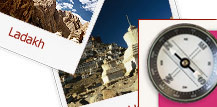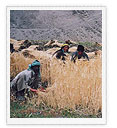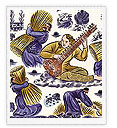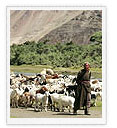

  |
|
| Ladakh TrekkkingToursLadakh TourismMonasteries FestivalsTrekking Adventure & ToursHotels in Ladakh |
     |
Ladakh Trekking Tours :: Ladakh People and LifestyleLadakh People and Life styleFeatures of PeopleThe people of Ladakh are hardy and tough akin to the rugged mountains which surround their dwellings yet very soft and plane at heart .With round faces, short noses, and chinki eyes they resemble more to the people of Tibet and central Asia than of India.The original population is believed to have been that of Dards, an Indo-Aryan race from down the Indus. But over years, a huge influx from Tibet overwhelmed the culture of the "Dards" and obliterated their racial characteristics. In eastern and central Ladakh, today's population seems to be mostly of Tibetan origin. Further west, in and around Kargil , there is much in the people's appearance that suggests a mixed origin. The exception to this generalization is the "Arghon", a community of Muslims in Leh, the descendants of marriages between local women and Kashmiri or Central Asian merchants. Influence of Buddhism in LadakhBuddhism reached Tibet from India via Ladakh, and there are ancient Buddhist frock engravings all over the region, even in areas like Drass and the lower Suru valley which today are inhabited by an exclusively Muslim population.The approach to a Buddhist Village is invariably marked by 'Mani' walls, which are ling chest-high structures faced with engraved stones bearing the Mantra "Om Mane Padme Hum" and by 'Chorten', commemorative cairns, like stone pepper-posts. Many villages are crowned with a 'Gompa' or monastery, which may be anything from an imposing complex of temples, prayer halls and monks' dwellings, to a tiny hermitage housing a single image and home to a solitary Lama. The Muslim InhabitantsIslam too came from the west. A peaceful penetration of the 'Shia' sect spearheaded by missionaries, its success was guaranteed by the early conversion of the Sub-rulers of Drass, Kargil and the Suru Valley. In these areas, 'Mani' walls and Chorten are replaced by mosques often-small unpretentious buildings, or 'Imambaras' imposing structures in the Islamic style, surmounted by domes of sheet metal that gleam cheerfully in the sun.Women of LadakhIn Leh area women of both the communities, Buddhist and Muslim, enjoy a greater freedom than other parts of the region. They not only work in the house and field, but also do business and interact freely with men other than their own relations. In Kargil and its adjoining regions on the other hand, it is only in the last few years that women are merging from semi-seclusion and taking jobs other than traditional ones like farming and house-keeping.Traditional Rituals and Leisure ActivitiesThe natural joie-de-vivre of the Ladakhis is given free rein by the ancient traditions of the region. Monastic and other religious festivals, many of which fall in winter, provide the excuse for convivial gatherings. Summer pastimes all over the region are archery and polo. Among the Buddhists, these often develop into open-air parties accompanied by dance and song, at which 'Chang', the local brew made from fermented barley, flows freely.Oral TraditionOf the secular culture, the most important element is the rich oral literature of songs and poems for every occasions, as well as local versions of the "Kesar Saga", the Tibetan national epic. This literature is common to both Buddhists and Muslims.CeremoniesCeremonial and public events are accompanied by the characteristic music of 'Surna' and 'Daman' (Oboe and drum), originally introduced into Ladakh from Muslim Baltistan, but now played only by Buddhist musicians known as "Mons". The first year of childbirth is marked by celebrations at different intervals of time, Beginning with a function held after 15 days, then after one month, and then again at the end of year. All relatives, neighbors and friends are invited and served with 'Tsampa', butter and sugar, along with tea by the family in which the child is born.Wedding ProcessThere is a mix of music and dance, joy and laughter, in the air whenever a marriage is held. The first day is spent in feasting at the bride's house, the second at the groom's place. The bride goes to live in the house of bridegroom after marriage. Boys are usually married or promised for marriage at about 16, girls at about 12. To make a proposal a relative of the boy goes to the house of the girl and gives a ring together with presents of butter, tea and 'Chang'. If the gifts are accepted then the marriage follows some months later. The boy offers a necklace and clothes to the girl. The parents of the girl give the couple clothes, animals and land if they are rich. These gifts are known as a "Raqtqaq" or dowry.Rules of InheritanceWhen the father of the family dies his place is taken by the eldest brother. The other brothers must obey the eldest brother. All inheritance of the family goes to the eldest brother and then to the next brother when he dies. If the family consists of all girls, then the father will bring the husband of the eldest daughter into the house and all land stays in the daughter's name and passes to her first son. Both sets of parents must accept the proposal of the boy for the girl. Usually the marriage is set by both sets of parents, who will choose a suitable partner for their child on the basis of manner, health and ability to earn income and look after a house.Leisure ActivitiesPolo and archery are the two favourite past times. In Leh, and may of the villages, archery festivals are held during the summer months, with a lot of fun and fanfare. Different teams from surrounding villages compete with each other in these archery festivals, and the shooting takes place according to strict etiquette, to the accompaniment of the music of surna and daman (oboe and drum). As important as the archery are the interludes of dancing and other entertainment. Chang, the local barley beer, flows freely, but there is rarely any rowdiness.Unlike the international game, Polo in Ladakh is not exclusively for the rich. Traditionally, almost every village had its polo-ground, and even today it is played with verve in many places.Probably introduced into Ladakh in the mid-17th century by King Sengge Namgyal, Polo played here differs in many respects from the international game. Here, each team consists of six players,and the game lasts for an hour with a ten minute break. Altitude notwithstanding, the hardy local ponies - the best of which come from Zanskar- scarcely seem to suffer, though play can be fast and furious. Each goal is greeted by a bust of music from surna and daman ; and the players often show extraordinary skill. For example, when starting play after a goal the scorer gallops up to midfield holding ball and mallet in the right hand, and throws the ball, hitting it in the same movement towards the opposite goal. Astrologers and Oracles of LadakhThe lamas are the vital intermediaries between the human and the spirit worlds. Not only do they perform the rites necessary to propitiate the gods, they also often take on the role of astrologers and oracles who can predict the auspicious time for starting any enterprise, whether ploughing the fields, arranging a marriage or going on a journey. The most famous monk-oracles are those of Matho Gompa. Chosen every three years by a traditional procedure, two monks spend several months in a rigorous regimen of prayer and fasting to prepare and purify themselves for their arduous role. When the time comes they are possessed by the deity, whose spirit enables them to perform feats that would be impossible to anyone in a normal state such as cutting themselves with knives, or sprinting along the gompa's topmost parapet. In this condition, they will answer questions put to them concerning individual and public welfare. However, the spirit is said to be able to detect questions asked by sceptical observers with the intention of testing him, and to react with frenzied anger. |